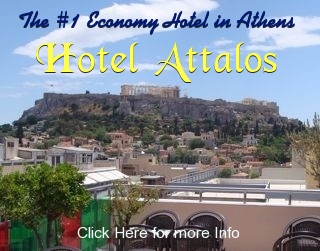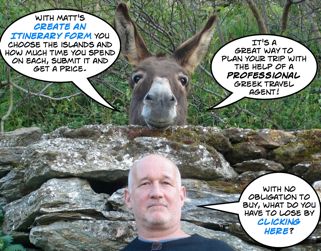Peloponessos
Messinia
|
Though very few tourists make it to the southwest corner of the Peloponessos it is not because it lacks beautiful beaches, charming port villages and impressive Venetian fortresses. It has all of these and much more. For those who know their history, the Messinians were the Helots, the Spartan slaves that did everything and allowed the Spartans to spend all their time training and fighting wars. If it were not for the Helots the Spartans would have been just another struggling city-state just like if it were not for African slaves the United States might not have become the power that it is today. |
|
|
|
OK. They say they are working hard to clean up the town and there are pleasant tavernas along the waterfront, an active nightlife with many live music venues, and lots and lots of arts-related events so don't let me convince you not to go there just because I might have seen one of the beaches on a bad day. Kalamata is after all, a city, and few tourists come to Greece to spend their holiday surrounded by apartment buildings. I will say this and it can apply to any city in Greece, no matter how awful it appears. If you are there with someone who knows the city you might just love it enough to overlook the problems that most cities have. Kalamata is no exception. I have friends who love it. They may not totally disagree with what I have written but things are improving in Kalamata and there is more to bring people to the city than a go-cart track. For instance... Kalamata is also famous for the Kalamata International Dance Festival held here every summer in July when thousand of visitors from all over the world, come to the city for performances, concerts, and art exhibitions. See also Diana Farr Louis' Guide to Kalamata |
|
|
|
|
|
|
|
|
|
On the way out of town we stopped at the wine cooperative and bought a couple gallons. The cooperative looks like a big factory on the right hand side of the street when you enter the town of Gialova and noting about the place looks like they would sell wine there but they do. The wine is a red called Nestor and the cooperative is the Agrotikos Oinopoitikos Synetairismos Messinias. In Pylos we stayed at the Hotel Miramare which overlooks the bay and the islands and is located just under the castle. The rooms are interesting in their decor and I don't know how to describe them except to say they had a sixties feel to them (Andrea says seventies so think platform shoes and Saturday Night Fever). But the hotel is owned by a retired sea-captain by the name of Nikos Houmis and he keeps the place clean and run efficiently. The location is great because it is right in the town on a side street yet it is on the beach and quiet. Nice little bar and the place seems cozy enough for winter tourism too. North of Pylos is area of Voidokilia which is not only a spectacular beach and wildlife area but a place of great historical value with evidence of habitation from the Neolithic period and just about every period since. It is the location of what is known as Nestor's cave. The Palace of Nestor near the village of Chora is on the hill of Ano Eglianos and though it is said to be the most intact of all the Mycenaean palaces there is not much that stands over a meter or so off the ground. Still it is a great view and if it is raining (like it was when we were there) the site is covered and you can walk around and keep dry. On the other side of the parking lot is a vaulted tomb, one of many in the area. The artifacts found in these tombs can be seen in the Archaeological Museum of Chora. Perhaps as impressive (actually more impressive) as the Palace of Nestor is the ancient olive grove which surrounds it with trees that are several hundred years old. Pylos is the home of the African Chameleon and in fact it is the only place they can be found in Europe. There are only 300 individual chameleons left and they are endangered, not because of natural predators, climate change or even tourism. They are endangered because the Greek Ministry of Agriculture has issued a license to the company Hippo Vlachos and Sons to collect 320 specimens and sell as pets. Not only the European Chameleon but birds, tortoises, snakes, tree frogs, lizards and other endangered species have been included in this plan to 'save' the species by collecting them all and selling them. Upset? Write to the Convention on International Trade in Endangered Species at cites@unep.ch If you visit the area buy the book A Road South: Chora, Pylos, Methoni by John A Biris. By far the best guide to the area and enjoyable reading too. You may be able to get it through Greece In Print or at one of the bookshops in Athens but if not you can find it in Pylos or Methoni. You can also try contacting the publisher: Ultrasound. 69-71 Iroon Politechnou Street. Pireaus. 185 36 Greece. Telephone:210 451 5577. Stay in luxury and Play Golf in Messinia
|
|
More Helpful Information |
|
Gaitses is a complex of four villages: Kentro(Biliova),Vorio(Brinta), Anatoliko(Nerinta) and Chora, and comprise a district of the Municipality of West Mani. This mountainous area has many water springs and some abandoned water mills. The Gaitses villages are located alongside Ridomo gorge and offer a fantastic view of it. There are no hotels in the villages however if you want to see what an authentic untouristy Greek village is like this is a wonderful place to come for the day. For information on these villages see http://gaitses.gr |
|
|

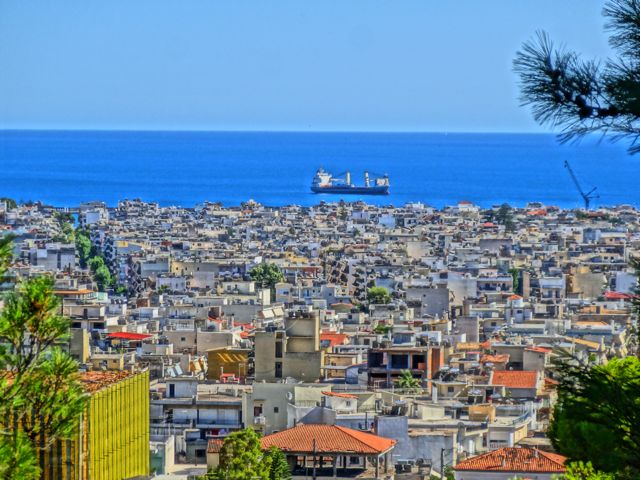 The
closest most tourists come to Messinia is by
eating the famous olives from Kalamata. When an
earthquake hit this town in 1986 more then 10,000
homes were destroyed but surprisingly many of its
older buildings and the impressive 13th century
castle still stands guard over the city. But
Kalamata, despite the familiarity of it’s name and
the charm of the people is not a prime reason to
visit the region, though if you are taking the
train from either side of the Peloponessos, this is
the last stop. If you are driving through Kalamata don't be dismayed by the canyons of apartment buildings and the garbage that people seem too busy to pick up. Kalamata despite looking like a big city is just like any town on a coastal plain and if you go east or west you can find your way out, maybe.
If you are really lucky or good at reading roadmaps you may discover Antassi beach, a 4k stretch of sand that has been awarded the Blue Flag as one of the cleanest beaches in the EU. There are hotels and rooms for rent and a large number of outdoor activities.
The
closest most tourists come to Messinia is by
eating the famous olives from Kalamata. When an
earthquake hit this town in 1986 more then 10,000
homes were destroyed but surprisingly many of its
older buildings and the impressive 13th century
castle still stands guard over the city. But
Kalamata, despite the familiarity of it’s name and
the charm of the people is not a prime reason to
visit the region, though if you are taking the
train from either side of the Peloponessos, this is
the last stop. If you are driving through Kalamata don't be dismayed by the canyons of apartment buildings and the garbage that people seem too busy to pick up. Kalamata despite looking like a big city is just like any town on a coastal plain and if you go east or west you can find your way out, maybe.
If you are really lucky or good at reading roadmaps you may discover Antassi beach, a 4k stretch of sand that has been awarded the Blue Flag as one of the cleanest beaches in the EU. There are hotels and rooms for rent and a large number of outdoor activities.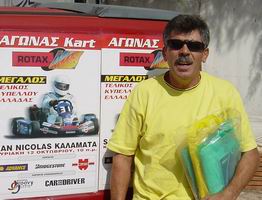 I love Kalamata olives and I would love to say something that would bring people flocking to the city. So if you love olives and you like funky working-class tavernas and especially if you love Go-Cart Racing then by all means visit Kalamata because the San Nikolas Pista-Go Cart on the
beach in the western part of Kalamata has to be the most amazing go-cart track in Greece or anywhere.
It is hard to miss since it is the only place on the coast with a giant ship in the front yard. The ship has been converted into a bar by Nicholas ("Not Saint Nicholas" he told me) who drives around the Peloponessos putting up his posters announcing big races.
I love Kalamata olives and I would love to say something that would bring people flocking to the city. So if you love olives and you like funky working-class tavernas and especially if you love Go-Cart Racing then by all means visit Kalamata because the San Nikolas Pista-Go Cart on the
beach in the western part of Kalamata has to be the most amazing go-cart track in Greece or anywhere.
It is hard to miss since it is the only place on the coast with a giant ship in the front yard. The ship has been converted into a bar by Nicholas ("Not Saint Nicholas" he told me) who drives around the Peloponessos putting up his posters announcing big races. 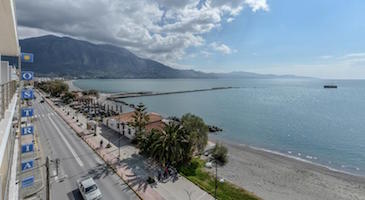 For Hotels in Kalamata see
For Hotels in Kalamata see 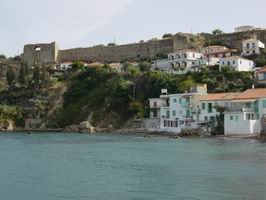 After an hour or so trying to find your way out of Kalamata
your time is better spent in the little port town
of Koroni with its lovely Zaga beach and its
Venetian castle and a string of tavernas and cafes in the port. There is a convent in the castle as well as some houses. The town is also famous for the Symposium Restaurant on the first street parallel to the port, owned by a friendly Greek-American named George who lived in New York. You won't have any trouble finding it as there are signs all over town and on the restaurant itself. If you want to eat in the port try the fish taverna Kagellarios and be sure to order the Koroni olives which are like kalamata
but bigger and juicier. On the road from Koroni to Methoni is the fishing village of Finikounda,
popular as one of the best windsurfing
destinations in Greece, with a string of fine
beaches, restaurants, hotels and campsites.
After an hour or so trying to find your way out of Kalamata
your time is better spent in the little port town
of Koroni with its lovely Zaga beach and its
Venetian castle and a string of tavernas and cafes in the port. There is a convent in the castle as well as some houses. The town is also famous for the Symposium Restaurant on the first street parallel to the port, owned by a friendly Greek-American named George who lived in New York. You won't have any trouble finding it as there are signs all over town and on the restaurant itself. If you want to eat in the port try the fish taverna Kagellarios and be sure to order the Koroni olives which are like kalamata
but bigger and juicier. On the road from Koroni to Methoni is the fishing village of Finikounda,
popular as one of the best windsurfing
destinations in Greece, with a string of fine
beaches, restaurants, hotels and campsites. 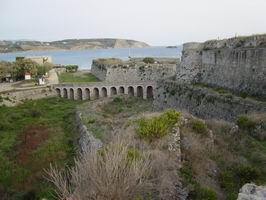 The
town of Methoni has a vast 13th century fortress
surrounded on three sides by the sea and the
fourth by a moat. Inside the fortress is an entire
medieval town and you can literally spend hours
wandering around. The name Methoni comes from the stones
that the small castle called the Bourtzi at the end of the peninsula
sits upon which protect the harbor and continue underwater to the uninhabited
island of Sapientza. Methoni is mentioned in the Illiad
when it was offered to the angry Achilles by Agememnon. It was fortified
in 369 BC and some of the original walls can be seen a little above
sea-level in the castle side overlooking the stone pier. It was
later used by the Byzantines and also used by pirates. In
1209 it was taken over by the Venetians and became one of the most
important fortified cities in the Mediterranean and called Modon
(Great name. Like something out of Lord of the Rings). To get into
the castle you cross over the moat on the arched bridge built
by the French Expeditionary Force of General N.J. Maison from 1828
to 1833 which replaced a wooden bridge. As you enter the main settlement
area of the castle you come to Morosini's Column which was erected
in 1483 during the first Venetian rule and then re-erected 203 years
later by Franccesco Morosini. Mysteriously there is no red granite
in the entire area of Messinia. So where did this column come from?
Nobody knows for sure but there is a nearly identical column in
the Piazza San Marco in Venice.
The
town of Methoni has a vast 13th century fortress
surrounded on three sides by the sea and the
fourth by a moat. Inside the fortress is an entire
medieval town and you can literally spend hours
wandering around. The name Methoni comes from the stones
that the small castle called the Bourtzi at the end of the peninsula
sits upon which protect the harbor and continue underwater to the uninhabited
island of Sapientza. Methoni is mentioned in the Illiad
when it was offered to the angry Achilles by Agememnon. It was fortified
in 369 BC and some of the original walls can be seen a little above
sea-level in the castle side overlooking the stone pier. It was
later used by the Byzantines and also used by pirates. In
1209 it was taken over by the Venetians and became one of the most
important fortified cities in the Mediterranean and called Modon
(Great name. Like something out of Lord of the Rings). To get into
the castle you cross over the moat on the arched bridge built
by the French Expeditionary Force of General N.J. Maison from 1828
to 1833 which replaced a wooden bridge. As you enter the main settlement
area of the castle you come to Morosini's Column which was erected
in 1483 during the first Venetian rule and then re-erected 203 years
later by Franccesco Morosini. Mysteriously there is no red granite
in the entire area of Messinia. So where did this column come from?
Nobody knows for sure but there is a nearly identical column in
the Piazza San Marco in Venice.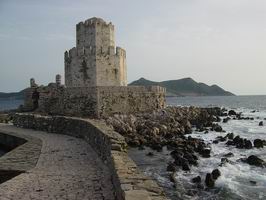 The Bourtzi at the south end of the main castle was built by the Turks in the 1500s and was a very scary place where people were imprisoned, tortured and executed, such as Gregorios Papatheodorou, the patron saint of Methoni who was martyred there in 1825. Methoni was also a place where slaves were sold.
You could buy
an old woman for a small fee to be used as a beast of burdon or for a bit more beautiful women, girls and boys. People too old or undesirable to be used as slaves were either imprisoned in the Bourtzi in such misery that execution was an act of mercy. To be fair to the building it also did a stint as a lighthouse and is one of the most photographed structures in the Peloponessos. You can cross the causeway to go in to the building and climb all the way to the top. Nowdays Methoni it is a much friendlier
place than it was during the Turkish occupation and with a shallow beach right in town it is perfect for familes with some nice tavernas nearby in a large platia. For a hotel in Methoni try the
The Bourtzi at the south end of the main castle was built by the Turks in the 1500s and was a very scary place where people were imprisoned, tortured and executed, such as Gregorios Papatheodorou, the patron saint of Methoni who was martyred there in 1825. Methoni was also a place where slaves were sold.
You could buy
an old woman for a small fee to be used as a beast of burdon or for a bit more beautiful women, girls and boys. People too old or undesirable to be used as slaves were either imprisoned in the Bourtzi in such misery that execution was an act of mercy. To be fair to the building it also did a stint as a lighthouse and is one of the most photographed structures in the Peloponessos. You can cross the causeway to go in to the building and climb all the way to the top. Nowdays Methoni it is a much friendlier
place than it was during the Turkish occupation and with a shallow beach right in town it is perfect for familes with some nice tavernas nearby in a large platia. For a hotel in Methoni try the 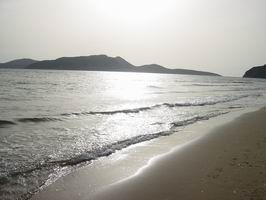 Below Methoni are the islands known as the Inousses which are all
uninhabited but feature very prominantly in Greek history because
of the many naval battles and shipwrecks here. The Spitha lighthouse
on Sapienza was built in 1892 and has been automated since
1989 which made the island's human habitation unessential. Sapienza
is rich in wildlife both on land and in the sea and is also used
by the Nestor Institute, based in Pylos, for its studies in astrophysics,
oceanography, siesmology and marine biology and it's on-going search
for nuetrinos. There are a couple beautiful beaches on Sapienza
but before you go be warned that during the hunting season try not
to be mistaken for a wild goat, pheasant, partridge or quail by
the hunters who pay as much as 200 euro for every goat they
bring back. (much cheaper at the market but I suppose it's not the
same thrill). There is also an underwater archaeological park where
local fishermen found a large number of granite columns and sarcophagi from
what was assumed to be a ship that has been carrying antiquities
from the city of Caesarea in Palestine. To be honest it is not yet
an archaeological park but there is hope that it will be in the
future and as in the rest of Greece you need permission to dive
there. In Vigli, the widest of the islands there are the
ruins from the Roman era and a stalactite cave called the 'black
hole'. Amargiani or Agia Marina is the smallest of the islands
and is covered with vegetation. On the 17th of July fishing boats
take people to the small dock for the panagiri (saint festival)
of Agia Marina.
Below Methoni are the islands known as the Inousses which are all
uninhabited but feature very prominantly in Greek history because
of the many naval battles and shipwrecks here. The Spitha lighthouse
on Sapienza was built in 1892 and has been automated since
1989 which made the island's human habitation unessential. Sapienza
is rich in wildlife both on land and in the sea and is also used
by the Nestor Institute, based in Pylos, for its studies in astrophysics,
oceanography, siesmology and marine biology and it's on-going search
for nuetrinos. There are a couple beautiful beaches on Sapienza
but before you go be warned that during the hunting season try not
to be mistaken for a wild goat, pheasant, partridge or quail by
the hunters who pay as much as 200 euro for every goat they
bring back. (much cheaper at the market but I suppose it's not the
same thrill). There is also an underwater archaeological park where
local fishermen found a large number of granite columns and sarcophagi from
what was assumed to be a ship that has been carrying antiquities
from the city of Caesarea in Palestine. To be honest it is not yet
an archaeological park but there is hope that it will be in the
future and as in the rest of Greece you need permission to dive
there. In Vigli, the widest of the islands there are the
ruins from the Roman era and a stalactite cave called the 'black
hole'. Amargiani or Agia Marina is the smallest of the islands
and is covered with vegetation. On the 17th of July fishing boats
take people to the small dock for the panagiri (saint festival)
of Agia Marina.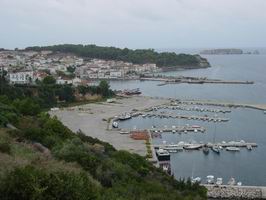 The town of Pylos, one of the
most attractive coastal villages in Greece was the
site of the
The town of Pylos, one of the
most attractive coastal villages in Greece was the
site of the 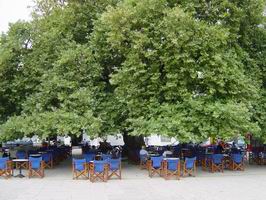 A
little more about Pylos because it was for me one of my favorite
places in the Peloponessos. The town has a big square which ends
at the port and features an enormous platanos tree that can probably
fit a hundred or so cafe tables beneath it. Pylos reminds me of
Greece in the sixties in many ways. Unspoiled by tourism the town
seems fairly self-sufficient and there are a number of interesting
shops that have little to do with tourism. There are a couple tourist
shops that have a good collection of books, many about the area.
Besides having the castle and being in an impressive setting at
the north end of a large bay which is sheltered from the Ionian
Sea by a string of islands with high cliffs the town was the home
of Kostis Tsiklitiras, the Greek Olympic athlete who won 4 medals
in the standing long and high jumps in London in 1908 and Stockholm
in 1912. His mansion in the port has a plaque but is now in ruins
which is unfortunate.
A
little more about Pylos because it was for me one of my favorite
places in the Peloponessos. The town has a big square which ends
at the port and features an enormous platanos tree that can probably
fit a hundred or so cafe tables beneath it. Pylos reminds me of
Greece in the sixties in many ways. Unspoiled by tourism the town
seems fairly self-sufficient and there are a number of interesting
shops that have little to do with tourism. There are a couple tourist
shops that have a good collection of books, many about the area.
Besides having the castle and being in an impressive setting at
the north end of a large bay which is sheltered from the Ionian
Sea by a string of islands with high cliffs the town was the home
of Kostis Tsiklitiras, the Greek Olympic athlete who won 4 medals
in the standing long and high jumps in London in 1908 and Stockholm
in 1912. His mansion in the port has a plaque but is now in ruins
which is unfortunate.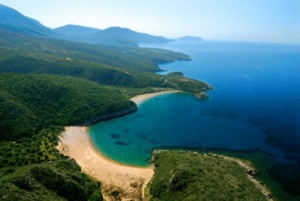 Set in an idyllic beachfront location in Messinia, the Westin Resort boasts a hydrotherapy spa and 123 private infinity pools. All elegant rooms come with flat-screen TVs and free Wi-Fi. Inspired by old Messinian mansions, the resort's villa clusters use natural stone and local design elements, in perfect harmony with the virgin sandy beach and pristine hillside
landscape. Decorated with contemporary furniture, light wood and muted tones of sea and sand, each of Costa Navarino’s guest rooms features a private balcony overlooking the resorts’ olive groves and landscaped gardens. The Westin Resort’s guests can enjoy a relaxing al fresco lunch, poolside refreshments and evening cocktails. Morias restaurant features a fresh-waffles-and-pancake station, while a wide variety of aromatic teas is served at the 1827 Lounge and Bar. Guests can indulge at the Anazoe Spa & Thalassotherapy
featuring an indoor pool or play a game of golf at the on-site Dunes Golf Course. Children will be delighted at the kids’ golf and kids’ tennis courts, the Navarino’s unique Sandcastle and the Cocoon playroom.
Set in an idyllic beachfront location in Messinia, the Westin Resort boasts a hydrotherapy spa and 123 private infinity pools. All elegant rooms come with flat-screen TVs and free Wi-Fi. Inspired by old Messinian mansions, the resort's villa clusters use natural stone and local design elements, in perfect harmony with the virgin sandy beach and pristine hillside
landscape. Decorated with contemporary furniture, light wood and muted tones of sea and sand, each of Costa Navarino’s guest rooms features a private balcony overlooking the resorts’ olive groves and landscaped gardens. The Westin Resort’s guests can enjoy a relaxing al fresco lunch, poolside refreshments and evening cocktails. Morias restaurant features a fresh-waffles-and-pancake station, while a wide variety of aromatic teas is served at the 1827 Lounge and Bar. Guests can indulge at the Anazoe Spa & Thalassotherapy
featuring an indoor pool or play a game of golf at the on-site Dunes Golf Course. Children will be delighted at the kids’ golf and kids’ tennis courts, the Navarino’s unique Sandcastle and the Cocoon playroom. 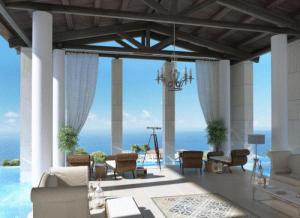 The Romanos Luxury Collection Resort is a brand new 5-star hotel with breathtaking views over the Ionian Sea and offers exquisitely appointed rooms and suites all of which have private terraces. Privacy reigns in the 289 rooms and 32 suites with private infinity pools. Traditional
Greek design with contemporary touches sets the tone in each space. At The Romanos Resort, Costa Navarino the rich history of the region blends harmoniously with the contemporary amenities offered. In addition to an elegant array of dining and leisure options, guests are invited to explore Navarino Dunes's 4,000 square meter Spa and Thalassotherapy Centre and the Bernhard Langer championship golf course - the first signature golf course in Greece.
The Romanos Luxury Collection Resort is a brand new 5-star hotel with breathtaking views over the Ionian Sea and offers exquisitely appointed rooms and suites all of which have private terraces. Privacy reigns in the 289 rooms and 32 suites with private infinity pools. Traditional
Greek design with contemporary touches sets the tone in each space. At The Romanos Resort, Costa Navarino the rich history of the region blends harmoniously with the contemporary amenities offered. In addition to an elegant array of dining and leisure options, guests are invited to explore Navarino Dunes's 4,000 square meter Spa and Thalassotherapy Centre and the Bernhard Langer championship golf course - the first signature golf course in Greece. 
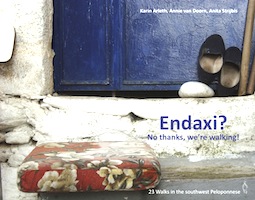 Endaxi? No thanks, we’re walking!: Annie van Doorn is a Dutch woman who lives in the southern Peloponesos. For several years she and her friends have been exploring Messinia’s tracks and hills by foot. After a few years, they decided to make a walking guide out of all their explorations.
They brought together all the information gathered on their walks and published: “Endaxi? No thanks, we’re walking!” In the book 23 walking tours in Messinia are presented and described in detail. In addition there is background information on this region of the Peloponnese, its places of interest, its beaches and, of course, the people who live here. And of course there are lovely photographs in the book. Over the past few years “Hiking“ has been making something of a come-back in Greece. Increasing
numbers of tourists are now also realising that outside high season, Greece, and specially the area Messinia, has much to offer: breathtakingly beautiful scenery and unspoiled natural countryside, all waiting to be discovered by those on foot. With this guide Annie and her friends hope to give a positive swing on active tourism. Available in either English, Dutch and German.
Endaxi? No thanks, we’re walking!: Annie van Doorn is a Dutch woman who lives in the southern Peloponesos. For several years she and her friends have been exploring Messinia’s tracks and hills by foot. After a few years, they decided to make a walking guide out of all their explorations.
They brought together all the information gathered on their walks and published: “Endaxi? No thanks, we’re walking!” In the book 23 walking tours in Messinia are presented and described in detail. In addition there is background information on this region of the Peloponnese, its places of interest, its beaches and, of course, the people who live here. And of course there are lovely photographs in the book. Over the past few years “Hiking“ has been making something of a come-back in Greece. Increasing
numbers of tourists are now also realising that outside high season, Greece, and specially the area Messinia, has much to offer: breathtakingly beautiful scenery and unspoiled natural countryside, all waiting to be discovered by those on foot. With this guide Annie and her friends hope to give a positive swing on active tourism. Available in either English, Dutch and German.
